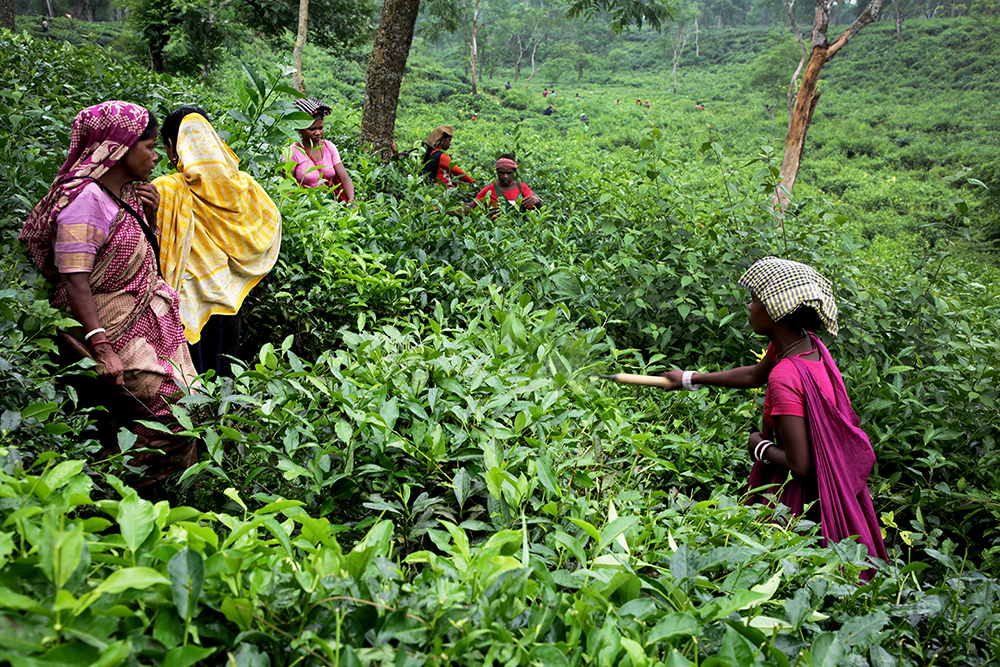
by admin | Oct 7, 2024 | Newspaper Report
হবিগঞ্জের ইমাম চা-বাগানে ব্যস্ত শ্রমিকের ছবিটি ২০২৩ সালের ২৬ আগস্ট তোলা। ছবি: ফিলিপ গাইন
 চা-শ্রমিকের প্রতি সুবিচার নিশ্চিত করতে আরেকটি উদ্বেগের বিষয় শ্রম আইন ও শ্রম বিধিমালায় তাদের প্রতি বৈষম্য।
চা-শ্রমিকের প্রতি সুবিচার নিশ্চিত করতে আরেকটি উদ্বেগের বিষয় শ্রম আইন ও শ্রম বিধিমালায় তাদের প্রতি বৈষম্য।
বকেয়া মজুরি পরিশোধ নিয়ে প্রায় সাত সপ্তাহ ধরে উদ্বেগের মধ্যে দিন কাটাচ্ছেন ন্যাশনাল টি কোম্পানি লিমিটেডের (এনটিসি) মালিকানাধীন ১২টি চা-বাগানের প্রায় ১২ হাজারের বেশি শ্রমিক। গত ১২ আগস্ট শ্রমিকদের ৫৯৫ টাকা করে দেওয়া হয়, যা তাদের সাপ্তাহিক মজুরির অর্ধেক। এরপর ২৫ সেপ্টেম্বরের আগ পর্যন্ত তারা কেউ কোনো মজুরি পাননি। ২৫ সেপ্টেম্বর তাদের সেই আগের বারের মতো ৫৯৫ টাকাই দেওয়া হয়। শ্রমিকদের জন্য এমন পরিস্থিতি নিঃসন্দেহে দুঃখজনক, কেননা আগামী ৯ অক্টোবর থেকে শুরু হবে হিন্দুদের প্রধান ধর্মীয় উৎসব দুর্গা পূজা। তারপরও শ্রমিকেরা বাগানের কাজ বন্ধ করেননি।
কাজ বন্ধ না হলেও বাগান কর্তৃপক্ষকে চাপে রাখতে কারখানার গুদাম থেকে উৎপাদিত চায়ের চালান বাইরে পাঠানো বন্ধ রেখেছে শ্রমিকরা। এ নিয়ে এনটিসি কর্তৃপক্ষ এবং সরকারের সংশ্লিষ্ট কর্মকর্তাদের সঙ্গে আলোচনার পর গত ১ অক্টোবর মৌলভীবাজারের কমলগঞ্জ উপজেলায় কোম্পানির সবচেয়ে বড় বাগান পাত্রখোলা টি এস্টেট থেকে দুটি এবং বাকি ১১টি থেকে একটি করে চালান ছাড়েন শ্রমিকরা। বিনিময়ে ওই দিনই এক সপ্তাহের মজুরি পান তারা, এমনটিই নিশ্চিত করেন পাত্রখোলা চা-বাগানের পঞ্চায়েত সভাপতি শিপন চক্রবর্তী। এখন এনটিসি কর্তৃপক্ষের কাছে শ্রমিকদের দাবি, দুর্গা পূজা শুরুর আগেই সব বকেয়া এবং বোনাস পরিশোধ করা হোক, না হলে গুদাম থেকে বাকি চালান ছাড়া হবে না।
এনটিসির বাগানগুলোতে এখন যে পরিস্থিতি, তার জন্য দায়ী সরকার ও রাজনৈতিক দূষণ। কোম্পানিজ অ্যাক্ট, ১৯১৩ এর অধীনে ১৯৭৮ সালে একটি পাবলিক লিমিটেড কোম্পানি হিসেবে গঠিত হয় এনটিসি। এতে সরকারের শেয়ার ৫১ শতাংশ এবং বাকি ৪৯ শতাংশের লেনদেন হয় ঢাকা ও চট্টগ্রাম শেয়ারবাজারে সাধারণ জনসাধারণের জন্য। কোম্পানির ১২টি বাগানের মধ্যে সাতটি মৌলভীবাজার, চারটি হবিগঞ্জ ও একটি সিলেটে অবস্থিত।
স্বাধীনতার পর এনটিসির বাগান সরকারি মালিকানায় চলে যায়। ভৌগলিক অবস্থান চা চাষের উপযোগী হলেও লাভের মুখ খুব একটা দেখতে পারেনি এই বাগানগুলো। বাগানগুলোর ব্যবস্থাপনা যে ভালো নয়, তা ছড়িয়ে-ছিটিয়ে থাকা চা গাছ এবং ছায়াবৃক্ষের অবস্থা দেখে বোঝা যায়। পত্রিকায় প্রকাশিত প্রতিবেদন অনুযায়ী, ২০২৩ সালের জুলাই থেকে ডিসেম্বর পর্যন্ত ছয় মাসে কোম্পানির লোকসান ছিল ২৬ কোটি ৬৬ লাখ টাকা।
কোম্পানির ব্যবস্থাপনায় এত সমস্যা অনেকাংশেই রাজনীতির কারণে। সমস্যা আরও ঘনীভূত হয় গত ৫ আগস্ট দেশের রাজনীতির আকস্মিক পট পরিবর্তনের পর। গণঅভ্যুত্থানে শেখ হাসিনা সরকারের পতনের পর কোম্পানির পরিচালনা পর্ষদ ভেঙে পড়ে। জানা যায়, পরিচালনা পর্ষদের চেয়ারম্যান, বর্তমানে পলাতক শেখ কবির হোসেন সম্পর্কে শেখ হাসিনার আত্মীয়।
চা-শ্রমিক এবং তাদের একমাত্র ইউনিয়ন বাংলাদেশ চা-শ্রমিক ইউনিয়ন একত্রে এনটিসি কর্তৃপক্ষের সঙ্গে দরকষাকষি চালিয়ে যাচ্ছে। এতকিছুর পরও শ্রমিকরা চরম ধৈরে্যর সঙ্গে বাগান ও কারখানার কাজ অব্যাহত রাখছেন শুধু এই আশায় যে কর্তৃপক্ষ তাদের কথা রাখবে ও দুর্গা পূজা শুরুর আগেই তাদের বকেয়াসহ সব মজুরি পরিশোধ করবে।
এনটিসির সামনে এখন কঠিন পথ। চা-বাগানের সঙ্গে সংশ্লিষ্ট এক শীর্ষ সরকারি কর্মকর্তা নাম প্রকাশ না করার শর্তে জানান, বাংলাদেশ কৃষি ব্যাংকের কাছে কোম্পানির ঋণের পরিমাণ ৩৮০ কোটি টাকা। চলতি বছর ব্যাংকটির কাছে আরও ১৫০ কোটি টাকা ঋণ চাইলেও ব্যাংক অনুমোদন দেয় ৮৬ কোটি টাকা, যা ইতোমধ্যে খরচ হয়ে গেছে-এমনটিই জানান তিনি। উল্লেখ্য, ঋণ পরিশোধের নিয়ম অনুযায়ী, নিলামে চা বিক্রি থেকে আয়ের একটি অংশ সরাসরি চলে যায় কৃষি ব্যাংকের অ্যাকাউন্টে ও আরেকটি অংশ পায় মালিকরা। এমন পরিস্থিতিতে দাবি আদায়ের জন্য শ্রমিকদের কারখানার গুদাম থেকে চালান বন্ধ করা ছাড়া আর কোনো উপায় ছিল না।
এনটিসি বাগানের এতসব বিশৃঙ্খলা রাষ্ট্রায়ত্ত ব্যবসার সাধারণ উদাহরণ হলেও এরকম অব্যবস্থাপনা ও দুর্নীতি আরও অনেক প্রাইভেট কোম্পানি ও ব্যক্তি মালিকানাধীন বাগানেও দেখা যাচ্ছে, যা চা-শ্রমিকদের গভীর সংকটে ফেলেছে। এর বড় উদাহরণ হবিগঞ্জ জেলার ইমাম অ্যান্ড বাওয়ানী টি এস্টেট। চা-বাগান সংশ্লিষ্ট সেই একই সরকারি কর্মকর্তার বরাতে জানা যায়, বাগান দুটি দীর্ঘদিন ধরেই সমস্যায় জর্জরিত। এর মধ্যে ইমাম চা-বাগান গত বছরের অক্টোবরে পুরোপুরি বন্ধ হয়ে যায়। আর, বাওয়ানী চা-বাগানের ব্যবস্থাপনার দায়িত্ব চলে যায় শ্রীমঙ্গলের বিভাগীয় শ্রম দপ্তরের উপ-পরিচালকের হাতে। এতসব অব্যবস্থাপনার ফলে উপ-পরিচালকের পক্ষে বাগান চালানো কঠিন। পাশাপাশি বাগান দুটির শ্রমিকদেরকে চরম ভোগান্তির শিকার হতে হচ্ছে।
মৌলভীবাজারের জুড়ী উপজেলার ফুলতলা চা-বাগান দুর্বল ব্যবস্থাপনার আরেকটি উদাহরণ। সরকারি কর্মকর্তা জানান, এই বাগানের প্রায় এক হাজার ৬০০ জনের মতো শ্রমিক ১২ সপ্তাহ ধরে কোনো মজুরি পাচ্ছেন না। বাগানের মালিক লন্ডনে থাকেন এবং বাগানটি তিনি বন্ধ করে দিয়েছেন-এমনটাই বলা হচ্ছে। যদিও শুধুমাত্র শ্রমিকদের কারণে উৎপাদন এখনো কিছুটা অব্যাহত আছে। সরকারি ওই কর্মকর্তা বলেন, ৫০ কোটি টাকার ব্যাংক ঋণ নিয়ে বর্তমানে বাগানের মালিক গভীর সংকটে আছেন।
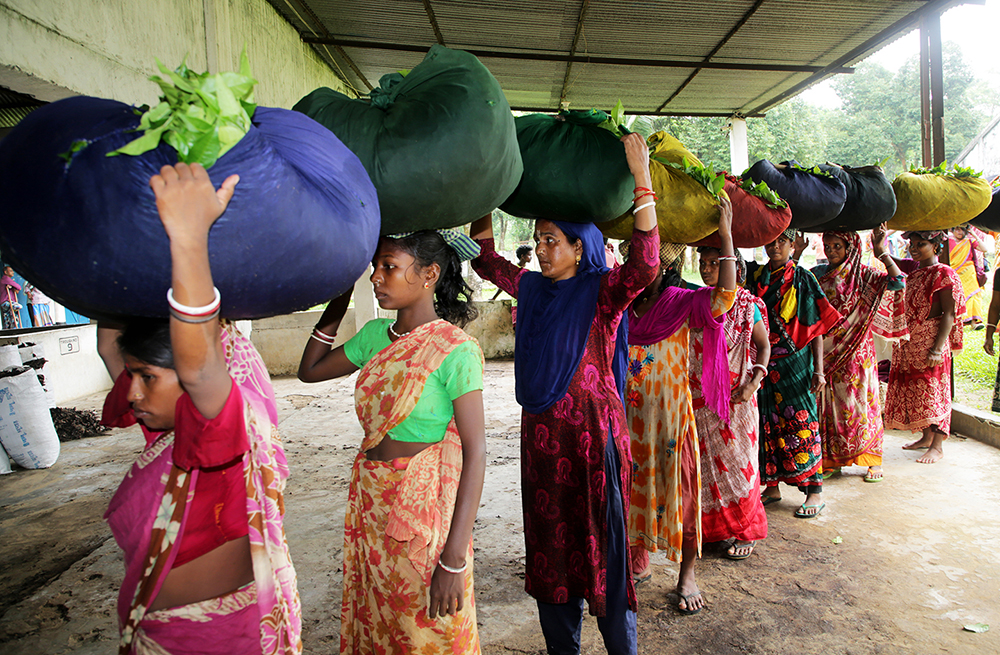
হবিগঞ্জের ইমাম চা-বাগানের নারী শ্রমিকরা সবুজ পাতার বোঝা নিয়ে ওজনঘরের সামনে। ছবিটি ২০২৩ সালের ২৬ আগস্ট তোলা। ছবি: ফিলিপ গাইন
ওই কর্মকর্তা আরও জানান, ৭৯টি চা-বাগানের অবস্থা বেশ খারাপ। এসব বাগান কয়েক মাস ধরে প্রভিডেন্ট ফান্ডে (পিএফ) অর্থ জমা দিচ্ছে না। বিল পরিশোধ না করায় অনেক চা-বাগানে গ্যাস ও বিদ্যুতের সংযোগ কেটে দেওয়া হয়েছে। ফলে নিজেদের কারখানা চালাতে না পেরে তাদের সবুজ চা-পাতা বিক্রি করে দিচ্ছে অন্য বাগানের কাছে।
অনেক বাগান মালিকের অভিযোগ, চায়ের নিম্নমুখী বাজার দর ও ঊর্ধ্বমুখী উৎপাদন খরচ তাদের সংকটের অন্যতম কারণ। প্রতি বছর সরকারের চা চাষ এলাকা সম্প্রসারণ নীতির কারণে চায়ের উৎপাদন বেড়ে চলেছে।
তবে, ভালো চা-বাগানেরও নজির আছে। এসব বাগান কর্তৃপক্ষ ভালোভাবেই তাদের বাগান পরিচালনা করছে, বর্তমান মজুরি ও অন্যান্য সুবিধা কাঠামোর মধ্যে থেকেই তাদের শ্রমিকদের ভালো যত্ন নিচ্ছে এবং ভালো মুনাফাও করছে। ইস্পাহানি টি লিমিটেড এমনই এক বাগানের উদাহরণ। এই কোম্পানির চারটি বাগান রয়েছে। যার মধ্যে অন্যতম মৌলভীবাজারের জেরিন টি এস্টেট। কর্তৃপক্ষ জানায়, দেশে একরপ্রতি গড় উৎপাদন যেখানে এক হাজার ৬০০ কেজির মতো, সেখানে জেরিন চা-বাগানের একক উৎপাদন তিন হাজার কেজি। ইস্পাহানির চারটি বাগানে প্রতি একরে গড়ে উৎপাদন হয় দুই হাজার ৫০০ কেজি ও বিক্রি থেকে আয়ও হয় ভালো। আরও জানা যায়, জেরিন চা-বাগানের লেবার লাইনের অধিকাংশ বাড়িই পাকা। ইস্পাহানির অন্যান্য বাগানেও লেবার লাইনের বাড়ির অবস্থা বাকি অনেক কোম্পানির বাগানের তুলনায় বেশ ভালো। ইস্পাহানি কর্তৃপক্ষের দাবি, তাদের বাগানে চা-শ্রমিকরা মজুরিসহ অন্যান্য সব সুবিধা ঠিকভাবেই পায়।
চা-শিল্পের বৃহত্তর স্বার্থ এবং চা-শ্রমিকদের সুরক্ষার জন্য ভালো পরিবর্তন অবশ্যই দরকার। বর্তমান অন্তর্বর্তীকালীন সরকার সমাজ থেকে বৈষম্য ও অসমতা দূরীকরণের যে অঙ্গীকার নিয়েছে, তার প্রতিফলন চা-শিল্প এবং চা-শ্রমিকদের ব্যাপারেও হওয়া উচিত। প্রায় এক লাখ ৪০ হাজার চা-শ্রমিক এবং তাদের পরিবার-সব মিলিয়ে প্রায় পাঁচ লাখের মতো মানুষ সেই ব্রিটিশ আমল থেকে শুরু হওয়া এই চা-শিল্পে প্রজন্মের পর প্রজন্ম ধরে চরম বৈষম্যের শিকার হয়ে আসছে।
প্রথমত, চা-শিল্পের বিশেষ করে বাগানগুলোর অবস্থার ভালো মানচিত্রায়ণ প্রয়োজন। ভালো বাগান ও খারাপ বাগান চিহ্নিত করে সেসবের কারণগুলো বিশ্লেষণ করা দরকার এবং কোনো বাগান অব্যবস্থাপনা, দুর্নীতি ও আর্থিক অনিয়ম করে যাতে নিষ্কৃতি না পায়, তার জন্য জোর সুপারিশ প্রণয়ন জরুরি। চা-শিল্পের সঙ্গে যেসব প্রতিষ্ঠান জড়িত, তাদের ব্যাপারে পুঙ্খানুপুঙ্খ তদন্ত চালাতে হবে এবং তাদেরকেও দায়বদ্ধ করতে হবে।
দ্বিতীয়ত, বাংলাদেশের নাগরিক হয়েও যে চা-শ্রমিকরা নাগরিকের সমান সুযোগ ও মর্যাদা থেকে বঞ্চিত থেকেছে বহুকাল, তাদের সার্বিক কল্যাণে সব ধরনের ব্যবস্থা গ্রহণের আন্তরিক প্রচেষ্টা থাকতে হবে। শুরু করতে হবে ন্যায়সঙ্গত ও সম্মানজনক মজুরি নির্ধারণের মাধ্যমে। সাবেক প্রধানমন্ত্রী ২০২২ সালের আগস্টে চা-শ্রমিকের জন্য যে ১৭০ টাকা মজুরি নির্ধারণ করে দিয়েছিলেন, তা মোটেই ন্যায্য ছিল না। অভিযোগ আছে যে, তিনি মালিকদের নির্দেশনামতো মজুরি নির্ধারণ করে দিয়েছিলেন এবং তার হস্তক্ষেপ ছিল রাজনৈতিক, যখন নিম্নতম মজুরি বোর্ডকে মজুরি কাঠামো নির্ধারণে ব্যর্থ হওয়ার সবরকম ব্যবস্থা করা হয়। এখন সময় এসেছে চা-শিল্পকে ঢেলে সাজিয়ে শ্রমিকের প্রতি সুবিচার নিশ্চিত করার।
চা-শ্রমিকের প্রতি সুবিচার নিশ্চিত করতে আরেকটি উদ্বেগের বিষয় শ্রম আইন ও ম্রম বিধিমালায় তাদের প্রতি বৈষম্য। তা ছাড়া মালিকরা প্রতিনিয়ত শ্রম আইনের যেসব ধারা লঙ্ঘন করে চলেছেন, তা কোনোভাবেই সমর্থন করা যায় না। মালিকরা ম্রম আইনের যেসব ধারা নিয়মিতভাবে লঙ্ঘন করেন, তা বিভিন্ন গবেষণা ও লেখালেখিতে প্রকাশিত হয়েছে। শ্রমিক, তাদের প্রতিনিধিত্বকারী ট্রেড ইউনিয়ন এবং সংশ্লিষ্ট অন্যদের সঙ্গে পরামর্শ করলে এ ব্যাপারে আরও বিস্তারিতভাবে জানা যাবে। যেসব সরকারি সংস্থা শ্রম আইন ও শ্রম বিধিমালা বাস্তবায়নের দায়িত্বে নিয়োজিত তারা যাতে সততার সঙ্গে তাদের দায়িত্ব পালন করে তা নিশ্চিত করা যেকোনো সরকারের জন্য একটি পরীক্ষা।
চা-শ্রমিক যাদের অধিকাংশই বাঙালি নন, হিন্দু ও আদিবাসী, অনেকটাই অদৃশ্য ও শক্তিহীন। ব্রিটিশ আমল থেকে মজুরি বঞ্চনা ও সামাজিক বিচ্ছিন্নতা তাদেরকে একটি দুর্বল জনগোষ্ঠীতে পরিণত করেছে। শিক্ষা ও অর্থনৈতিক অগ্রগতির ক্ষেত্রেও তারা অনেক পিছিয়ে আছেন। কেবল সমান সুযোগই তাদের জন্য যথেষ্ট নয়। বর্তমান অবস্থা থেকে বেরিয়ে আসতে বাড়তি কিছু সুবিধার দাবি তারা করতেই পারেন। তাদের প্রতি অন্তর্বর্তী সরকারের বড় দায়িত্ব রয়েছে।
ফিলিপ গাইন: গবেষক ও সোসাইটি ফর এনভায়রনমেন্ট অ্যান্ড হিউম্যান ডেভেলপমেন্টের (সেড) পরিচালক
News Link: bangla.thedailystar.net

by admin | Oct 7, 2024 | Newspaper Report
Women tea workers of Bawani tea garden in Habiganj carrying headloads of green tea leaves, on August 26, 2024. PHOTO: Philip Gain
For nearly seven weeks, more than 12,000 tea workers in 12 tea gardens under the National Tea Company Limited (NTC) have been living in anxiety about the payment of their wages. After they were paid Tk 595 on August 12, which is half of the weekly payment, the payment was halted till September 25, the day they were paid another instalment of the same amount. This is pretty bad for these workers as the Durga Puja festivities are set to begin on October 9. Thankfully, they have not stopped work and production.
However, to keep the management under pressure, the tea workers blocked consignments of made tea out of the garden warehouses. After a negotiation with the management and relevant state agencies, they allowed the release of two consignments from Patrokhola Tea Estate in Moulvibazar’s Kamalganj upazila, the largest tea garden of the NTC, and one consignment from each of the 11 other tea gardens on October 1. In exchange, they were paid a week’s salary on the same day, confirmed Shipon Chakraborty, panchayat president of Patrokhola. Now the deal is, these workers will release the next consignments from the warehouses when the NTC management clears dues and bonus before Durga Puja.
What we see in the NTC gardens is bad management. NTC is a public limited company formed in 1978 under the Companies Act, 1913. The state holds 51 percent of the shares, and 49 percent are traded in Dhaka and Chattogram stock markets for the general public. Of its 12 tea gardens, seven are located in Moulvibazar, four in Habiganj, and one in Sylhet.
The NTC management, for which the government is responsible, is polluted by politics. The tea gardens, taken over by the government after independence, are located in a good topographic zone, yet they perform very poorly. According to a news report, between July and December of 2023, the company posted a net loss of Tk 26.66 crore. The company’s lousy tea garden management is manifested in the look of its gardens: tea plants are sparse and without enough shade trees, among other things. The company’s troubles have gotten worse since the sudden political change on August 5, following which the chairman of the company’s board of directors, Sheikh Kabir Hossain, reportedly a relative of ousted Prime Minister Sheikh Hasina, has disappeared and the board has almost collapsed.
The tea workers and their lone union, Bangladesh Cha Sramik Union (BCSU), are trying to negotiate with the NTC management. Half-fed or with an empty stomach, these workers have been showing their patience and working regularly in the hope that the management will stay true to its words and clear the full payment of their due wages and bonus before Durga Puja, the biggest festival of Hindus in Bangladesh.
However, NTC now faces many insurmountable challenges. According to a top government official dealing with tea gardens, it has a debt of Tk 380 crore with the Bangladesh Krishi Bank. This year, the company requested for a loan of Tk 150 crore, but the bank sanctioned Tk 86 crore only, which got exhausted by July, said a government official dealing with tea gardens, on condition of anonymity. Per the arrangement of loan repayment, brokers in auction houses transfer the bank’s share of sale proceeds directly to its account. The owners get their shares. But the workers are left with no other option but to block the made tea consignments.
While NTC gardens show serious anomalies—which is typical of state-run businesses—there are other private companies and proprietors in the industry that are also plagued with mismanagement and corruption that put their workers in deep crisis. The Imam and Bawani tea estates in Habiganj are a prime example here. The government official disclosed that Imam tea garden was completely shut down along with its factory in October last year after a prolonged crisis. The responsibility for the management of Bawani estate was vested on the deputy director of labour (DDL) in Sreemangal as a result. But the DDL has been having a hard time managing the estate. And the workers of these two gardens are also suffering.
Another example of bad tea garden management is Fultala Tea Garden in Moulvibazar’s Juri upazila. Around 1,600 workers in this tea garden have not gotten paid for 12 weeks, as a government official told me. The owner lives in London and has reportedly shut down the garden, though it is still in production to some extent because of the workers. With a bank loan of Tk 50 crore, the owner is in deep trouble, the government official disclosed.
The official further revealed that 79 tea gardens are in terrible shape. These gardens have not made their due contributions to the Provident Fund (PF) for months. Gas and power lines have been cut off in a number of the gardens for not paying the bills. Many of them are selling green tea leaves to other tea gardens for processing as their own factories are not running.

Tea workers busy at Bawani tea garden in Habiganj, on August 26, 2024. PHOTO: PHILIP GAIN
Many tea garden owners argue that they are in trouble because the price of tea has gone down while the production cost is rising. Indeed, the government has a policy to expand the tea-growing areas that contribute to increasing production.
Of course, there are examples of good companies that manage their gardens well, take good care of their workers within the existing framework, and make good profits. One such company is Ispahani Tea Limited, which has four gardens. The best among them is Zareen, located in Moulvibazar. While the average production per acre is around 1,600kg, its per acre production is 3,000kg, and the per acre production of all four gardens averages around 2,500kg, according to management. The price that the company gets is good. Almost all houses in the labour lines at Zareen Tea Estate are pucca. The condition of houses in other tea gardens of Ispahani are also much better than in other tea gardens. The workers get better deals with other fringe benefits, the Ispahani management claims.
It is in the best interest of the tea industry in Bangladesh, not to mention the workers, that changes happen for the better. The interim government, which has committed itself to reforms to end discrimination and inequality, should consider giving immediate attention to the tea industry that is in disarray as a whole. The tea garden workers, around 140,000 of them, and their community of around half a million people have been facing severe discrimination for generations, since the beginning of the industry during British colonial times.
of all, the tea industry, specifically the tea gardens, need proper mapping. Good gardens and bad gardens need to be identified and the reasons must be explained for chalking out recommendations to bring the necessary changes so that none of the tea gardens are beyond scrutiny for mismanagement, corruption, and financial misappropriation. All parties involved with the tea industry must come under scrutiny and be made accountable.
Second, clear attempts must be made to ensure the well-being of tea garden workers, who are deprived of equal treatment and dignity as citizens of Bangladesh. To begin with, a just and respectable wage structure must be fixed for these workers. The former prime minister fixed their daily cash wage at Tk 170 in August 2022, which is certainly not fair. She was allegedly guided by the owners of tea gardens, and her move was political when the minimum wage board was made to fail. Now the time has come to overhaul the tea industry to ensure justice for the tea workers.
Another concern while dealing with their well-being is discrimination in the labour laws and regulations for them, and the owners’ routine violation of several sections of the labour legislation, which cannot be justified in any way. While these anomalies have been exposed on various platforms, fresh consultations with tea workers, their trade union and others concerned, will definitely help bring out more details. It is a test for any government to make sure that the state agencies under the labour ministry who are responsible for executing the labour law and rules act honestly.
Tea garden workers, most of whom belong to minority communities, are largely invisible and voiceless. Wage deprivation and social exclusion from the British colonial times have rendered them a weak population, left behind in terms of education and economic progress. Equal opportunities are not enough for them. They deserve some preferential treatment to help them get out of their current condition. The interim government has a big responsibility here.
Philip Gain is researcher and director at the Society for Environment and Human Development (SEHD). He can be reached at philip.gain@gmail.com
News Link: English.thedailystar.net | PDF
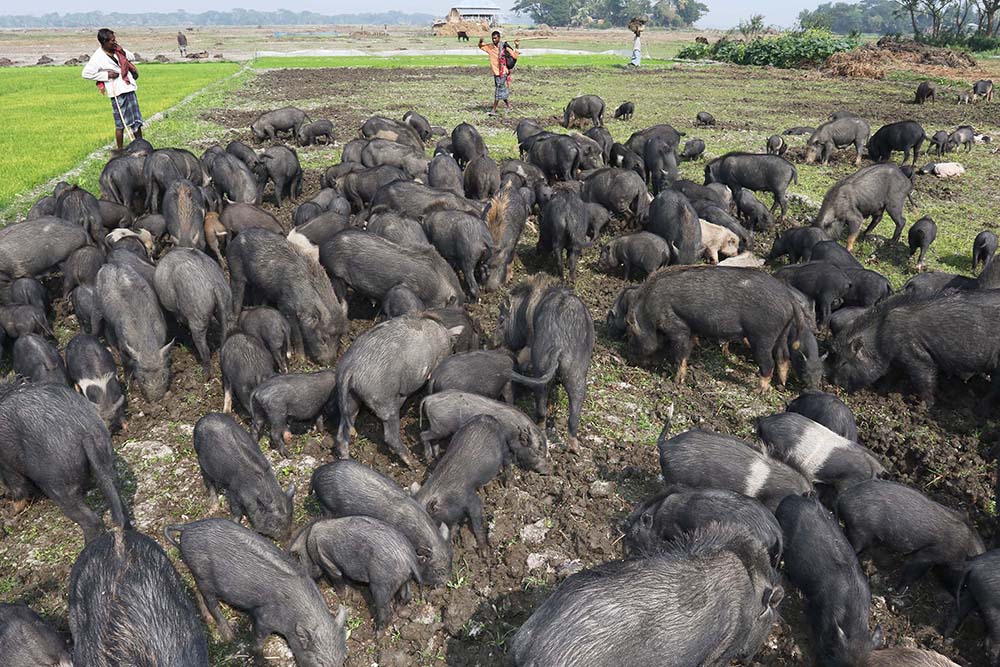
by admin | Jun 7, 2024 | Newspaper Report
গোপালগঞ্জের রামদিয়ায় শূকরের পাল, ২০১৭। ছবি: ফিলিপ গাইন
 সরকারি অভিধানে তারা ‘কাওরা’ হিসেবে চিহ্নিত। সাধারণ জনগণও সাধারণভাবে তাদেরকে ‘কাওরা’ বলেই ডাকে। তারা খোলা মাঠে শূকর পালন করেন। বাংলায় ‘কাওরা’ শব্দটি শূকরের সঙ্গে বসবাসকারী একটি গোষ্ঠীর প্রতি চরম অবজ্ঞা প্রদর্শন করে। বাংলায় এ শব্দটি গালির সমার্থক। ইদানীং এই গোষ্ঠী নিজেদেরকে পরিচয় দিতে ‘কায়পুত্র’ শব্দটি চালু করেছে। এটি তাদের জন্য একটি সম্মানজনক শব্দ।
সরকারি অভিধানে তারা ‘কাওরা’ হিসেবে চিহ্নিত। সাধারণ জনগণও সাধারণভাবে তাদেরকে ‘কাওরা’ বলেই ডাকে। তারা খোলা মাঠে শূকর পালন করেন। বাংলায় ‘কাওরা’ শব্দটি শূকরের সঙ্গে বসবাসকারী একটি গোষ্ঠীর প্রতি চরম অবজ্ঞা প্রদর্শন করে। বাংলায় এ শব্দটি গালির সমার্থক। ইদানীং এই গোষ্ঠী নিজেদেরকে পরিচয় দিতে ‘কায়পুত্র’ শব্দটি চালু করেছে। এটি তাদের জন্য একটি সম্মানজনক শব্দ।
আপনি যদি দেশের দক্ষিণ-পশ্চিমাঞ্চলীয় জেলা বিশেষ করে সাতক্ষীরা, যশোর, খুলনা, কুষ্টিয়া, ফরিদপুর, গোপালগঞ্জ, বরিশাল, নড়াইল, ইত্যাদির মধ্য দিয়ে ভ্রমণ করেন, তবে হয়তো রাস্তার ধারে বা বিলের মধ্যে শূকরের পাল দেখতে পাবেন। একটি শূকরের পালে সাধারণত ২০০ থেকে ৫০০ কালো শুকর থাকে, যা দেখতে প্রায় বুনো শূকরের মতো। মুসলিম প্রধান বাংলাদেশে শূকর অপবিত্র এবং তাই অবাঞ্ছিত বলে বিবেচিত হয়।
দক্ষিণ-পশ্চিমাঞ্চলের জেলাগুলো থেকে আসা শূকরের মাংসের চাহিদা অমুসলিমদের কাছে এবং বিশেষ করে ঢাকার বড় বড় হোটেলগুলোতে রয়েছে। দেশের দক্ষিণ-পশ্চিমাঞ্চলের জেলাগুলো থেকে আসা শূকরের মাংস ছাড়া ঢাকার খ্রিস্টানরা তাদের উৎসব ভাবতেই পারেন না। প্রকৃতপক্ষে, এই নিচু জেলাগুলোতে খোলা মাঠে লালন-পালন করা কালো শূকরগুলিকে নিয়মিতভাবে ঢাকার অদূরে কালীগঞ্জের নাগরিতে জবাই করা হয় এবং ফার্মগেটের দোকানে আনা হয়। এ বড় বড় মাংস হোটেলগুলোতেও সরবরাহ করা হয়।
ক্ষুদ্র জাতিগোষ্ঠীর মানুষেরা বাড়িতেও শূকর পালন করে। তারা খ্রিস্টান, বৌদ্ধ ও হিন্দু সম্প্রদায়ের মানুষ এবং অত্যন্ত আনন্দের সঙ্গে শূকরের মাংস খায়। দেশের সংখ্যাগরিষ্ঠদের কাছে শূকর অপবিত্র প্রাণী বিধায় শূকরের মাংস এখনো সস্তা। এর পুরো কৃতিত্ব কায়পুত্রদের।
শূকরের পাল ও তাদের ঘিরে থাকেন যেসব কায়পুত্র, তারা রাখাল বলে পরিচিত। অনেক দিন আমি তাদের সঙ্গে ভোর থেকে সন্ধ্যা অব্দি আনন্দের সঙ্গে সময় কাটিয়েছি। শীতকালে এরা সবচেয়ে আকর্ষণীয়। বর্ষাকালে ছয় মাসেরও বেশি সময় ধরে জলের নিচে থাকা বিলগুলো শূকরের পালকে প্রচুর খাবার উপহার দেয়। এ সময় খেয়েদেয়ে হৃষ্টপুষ্ট হয়ে ওঠে এ প্রাণীটি। জীবন্ত ও খাবার মতো যেকোনো কিছুর জন্য শূকরেরা কাদামাটি ঘাটতে থাকে। কেঁচো ও ঘুগরা থেকে শুরু করে সব ধরনের শেকড় জাতীয় খাদ্য যেমন: ঘেচু, কচু, শালুক, চিচরে ও বাদলা (বর্ষাকালে জলাভূমিতে জন্মানো বুনো উদ্ভিদ) খোলা জায়গায় বড় হওয়া শূকরের পাল ভোর থেকে সন্ধ্যা পর্যন্ত খেতে থাকে।
বিলের বুনো উদ্ভিদ খেয়ে শূকরের পাল কৃষকদের বড় উপকার করে। এক একর জমিতে পাঁচশো শূকরের একটি পাল যদি কয়েক ঘণ্টা ধরে খায়, তবে তা বিনামূল্যে চাষ হয়ে যায়। অল্প পরিশ্রমে কৃষকরা তখন ধানের চারা লাগাতে পারে। শূকরের পাল এলে অনেক জায়গায় কৃষকরা খুশি হয়। কারণ শুকরের পাল জমিকে আগাছামুক্ত করে দেয়।
২০১৭ সালে গোপালগঞ্জের কাজুলিয়া বিলে কয়েকটি পালে দুই হাজারের বেশি শূকর পেয়েছিলাম। ২০২৩ সালে নড়াইলের ইছামতি বিলে কয়েকটি পালের মধ্যে একই সংখ্যক শূকর পেয়েছি। আমার কাছে শূকরের পালগুলো বিস্ময়কর।
প্রায় ২০১৬ সাল থেকে কায়পুত্রদের নিয়ে গবেষণা করতে গিয়ে আমরা বেশ কয়েকটি জেলায় শূকরের পালকে অনুসরণ করে আসছি। কায়পুত্রদের বলা যায় বাংলাদেশের সবচেয়ে দরিদ্র ও দুর্দশাগ্রস্ত জনগোষ্ঠীগুলোর মধ্যে একটি। সাতক্ষীরা, যশোর ও খুলনা জেলার গ্রামে তাদের পরিবারের বাস এবং তারা পরিবার ছেড়ে সারা বছর শূকরের সঙ্গে খোলা মাঠে থাকে। ৫০০ শূকরের একটি পালের জন্য প্রায় এক ডজন শক্তিশালী রাখালের প্রয়োজন হয়।
রাখালদের যে বিষয়টি আমার সবচেয়ে বেশি ভালো লাগে তারা যত্নের সঙ্গে শূকর বড় করে। শূকরের মতো এমন বুদ্ধিমান প্রাণীর সঙ্গে যোগাযোগের বিশেষ দক্ষতা আছে তাদের। যেমনটি ইউভাল নোয়াহ হারারি শূকর সম্পর্কে তার গ্রন্থ সেপিয়েন্সে ব্রিফ হিস্ট্রি অব হিউম্যানকাইন্ডে লিখেছেন, ‘স্তন্যপায়ী প্রাণীদের মধ্যে শুকর সবচেয়ে বুদ্ধিমান এবং অনুসন্ধিৎসু, সম্ভবত বানর জাতীয় প্রাণীদের মধ্যে বুদ্ধিমত্তায় মানুষের পরই এদের স্থান।’
এ বিষয়টি আমি চাক্ষুষ প্রত্যক্ষ করেছি। এখানে অবশ্যই বলতে হয় যে, বেব নামক এক হলিউড সিনেমায় অভিনয় করে একটি শূকর একাডেমি পুরস্কারও পেয়েছে। শূকরের কিডনি ইতোমধ্যেই সফলভাবে মানুষের শরীরে প্রতিস্থাপন করা হয়েছে। এই দুটি প্রজাতির দেহের টিস্যু—মানুষ ও শূকর—নাটকীয়ভাবে মেলে। কে জানে, হয়তো এই কালো শূকরই ভবিষ্যতে একদিন অমূল্য হিসেবে প্রমাণিত হবে!
রাখালরা বলা চলে শূকরদের নিত্যসঙ্গী—তারা শূকরকে খাওয়ায়, দিনরাত তাদের সঙ্গে থাকে ও কথা বলে। শূকররাও তাদের কথা শোনে এবং তাদের নির্দেশ অনুসরণ করে। বিলের কাছে থাকা এই রাখাল ও শূকরের জীবনটা আশ্চর্য রকম সুন্দর, এটা আমাদের নজরে তেমনভাবে আসে না। আমরা সাধারণত তাদের তখনই দেখি যখন তারা এক জায়গা থেকে অন্য জায়গায় যাওয়ার জন্য শূকর নিয়ে রাস্তায় ওঠে বা শূকরগুলো রাস্তার পাশে খাবার খায়।
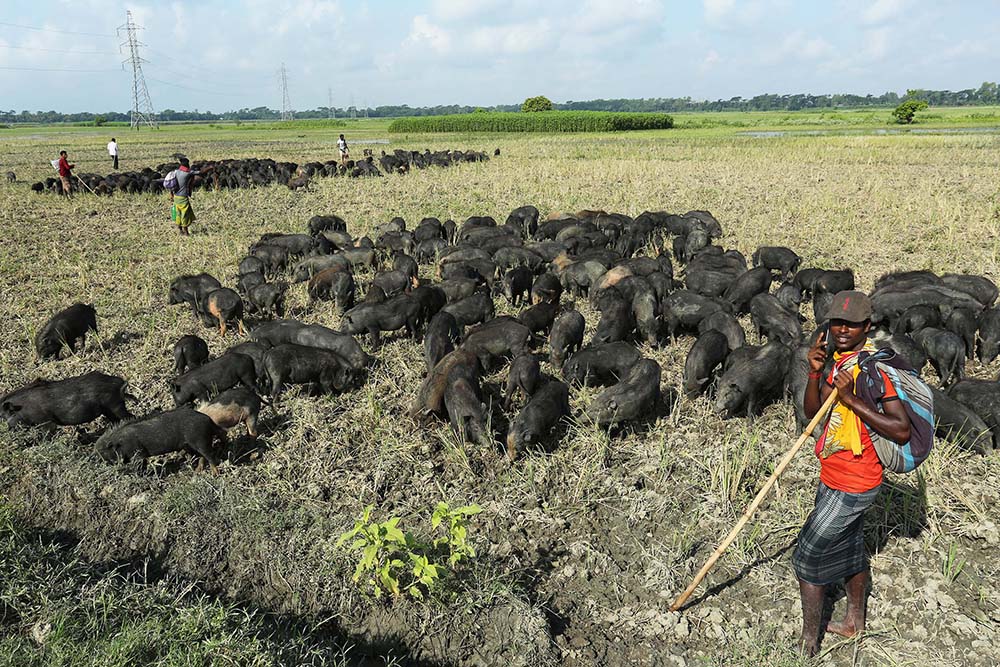 শূকরের পাল নিয়ে রাখাল, গোপালগঞ্জ, ২০১৬। ছবি: ফিলিপ গাইন
শূকরের পাল নিয়ে রাখাল, গোপালগঞ্জ, ২০১৬। ছবি: ফিলিপ গাইন
কারা এই রাখাল? কোথায় তাদের বসবাস?
সোসাইটি ফর এনভায়রনমেন্ট অ্যান্ড হিউম্যান ডেভেলপমেন্ট (সেড) ২০১৯ সালে কায়পুত্র অধ্যুষিত সব গ্রামে নিবিড় গবেষণা চালায় এবং ‘কায়পুত্র: শূকর চরানো গোষ্ঠী’ শীর্ষক একটি গ্রন্থ প্রকাশ করে। গবেষণায় সেড যশোর, সাতক্ষীরা ও খুলনা জেলার ৪৬টি গ্রামে কায়পুত্রদের খোঁজ পায়। এ গ্রামগুলোর মধ্যে ৪১টি গ্রামের কায়পুত্ররা তাদের ঐতিহ্যবাহী পেশা—খোলা মাঠে শূকর চরানোর সঙ্গে সম্পৃক্ত। বাকি পাঁচটি গ্রামের কায়পুত্ররা রাখাল হিসেবে আর কাজ করে না। এই ৪৬টি গ্রাম ছাড়াও সেড এই তিন জেলায় আরও ২৯টি গ্রামের খোঁজ পায় যেখানে কায়পুত্ররা মৎস্যজীবীতে পরিণত হয়েছে। তারা তাদের ঐতিহ্যবাহী পেশা শূকর পালনে আর আগ্রহী নয় এবং নিজেদের কায়পুত্র হিসেবেও পরিচয় দিতে চায় না।
দেশে কায়পুত্র জনগোষ্ঠীর সংখ্যা আনুমানিক ১২ হাজার। কায়পুত্রদের দেওয়া তথ্য অনুসারে, ২০১৮ সালে তাদের মোট শূকরের পাল ছিল ১০২টি এবং শূকর ছিল ১৬ হাজার ২৯৬টি। তারা তাদের বাড়িতেও কিছু শূকর পালন করে।
কায়পুত্রদের সবাই হিন্দু ধর্মাবলম্বী হলেও হিন্দু বর্ণপ্রথার চার বর্ণের বাইরে তাদের অবস্থান এবং অস্পৃশ্য হিসেবে বিবেচিত। তাদের মতো এত নিগৃহীত, বঞ্চিত, সামাজিকভাবে বিচ্ছিন্ন ও দরিদ্র গোষ্ঠী দক্ষিণ-পশ্চিমাঞ্চলে আর নেই।
গত ৭ ও ৮ এপ্রিল আমি সাতক্ষীরা সদর উপজেলার আলিপুর ইউনিয়নের দক্ষিণ আলিপুরে (২ নম্বর ওয়ার্ড) একটি কায়পুত্র পাড়ায় যাই। এখানে বসবাসরত ৪৭টি কায়পুত্র পরিবারের—সাতক্ষীরা-শ্যামনগর মহাসড়কের পশ্চিম পাশে ৩৯টি এবং পূর্ব পাশে আটটি—অবস্থা অত্যন্ত শোচনীয়। তাদের অনেকে ঝুপড়িতে বাস করে। এখানকার কায়পুত্ররা জানায়, ৪৭টি পরিবার সরকারি খাসজমিভুক্ত এ জায়গাটিতে বেশ কয়েক দশক ধরে বাস করছে।
এই কায়পুত্র পাড়ার অন্তত ৫০ জন পুরুষ (রাখাল) শূকরের পাল চরাতে বাইরে আছেন। তাদের মাসিক বেতন তিন থেকে নয় হাজার টাকা। সঙ্গে তারা দৈনিক খাবারের জন্য কিছু ভাতাও পায়।
দক্ষিণ আলীপুরের এই কায়পুত্র পাড়ার একটি মর্মস্পর্শী দিক হলো, এ গ্রামের অন্তত ২৫ জন নারী বিধবা কিংবা ‘স্বামী পরিত্যক্তা’ এবং তারা পার্শ্ববর্তী এলাকায় ভিক্ষা করেন। তাদেরই একজন কল্যাণী মণ্ডল, যার বয়স ষাটেরও বেশি। তার স্বামী ছিলেন একজন রাখাল, মারা গেছেন অনেক বছর হলো। স্বামীর মৃত্যুর পর থেকেই ভিক্ষা করছেন কল্যাণী। তার এক মেয়ে, যার বিয়ে হয়ে গেছে। তালপাতা, পলিথিন ও জং ধরা টিনের তৈরি ছয় ফুট বাই ছয় ফুট আয়তনের একটি ঝুপড়িতে কল্যাণী থাকেন। বৃষ্টি পড়লে ঘুমানোর উপায় নেই, বসে থাকতে হয়। তিনি শারীরিকভাবে প্রতিবন্ধী। লাঠিতে ভর করে তাকে হাঁটতে হয়। বিধবা ভাতা হিসেবে তিনি যা পান, তা খুবই সামান্য। ভিক্ষা ছাড়া বেঁচে থাকার তার আর কোনো পথ নেই।
‘আমরা ভিক্ষা করি এবং আমাদের পুরুষেরা শূকর পালনের কাজ করে। তাই প্রতিবেশীরা আমাদেরকে ঘৃণার চোখে দেখে’, বলেন শেফালি মণ্ডল (৩৫)। তিনিও ভিক্ষা করেন এবং মাঝেমধ্যে শ্রমিক হিসেবে কাজ করেন।
‘বাজারে চায়ের দোকানে ও হোটেলে আমাদের জন্য থাকে আলাদা কাপ ও প্লেট। আমরা সমাজে অন্য মানুষের সমান না’, বলেন তিনি।
জানা গেছে, সরকার সাতক্ষীরা-শ্যামনগর মহাসড়কটি চার লেনে সম্প্রসারণের পরিকল্পনা নিয়েছে। এজন্য কায়পুত্রদের এই জায়গা খালি করতে বলা হয়েছে। সম্পূর্ণ ভূমিহীন এসব কায়পুত্র পরিবারের যাওয়ার আর কোনো জায়গা নেই।
পুনর্বাসনের বিষয়ে তাদেরও কিছু পরামর্শ আছে। ‘আমরা ভূমিহীন এবং আমাদের বাসস্থানের অবস্থা এতটাই করুণ যে আমারা গৃহহীনের পর্যায়েই পড়ি’, বলেন চায়না মণ্ডল। তার দুই ছেলে রাখাল এবং তিনি নিজে মাঝেমধ্যে ভিক্ষা করেন। তিনি আরও বলেন, ‘আমাদের এই জায়গার পশ্চিমে অনেক খাস জমি আছে। আশ্রয়ণ প্রকল্পের আওতায় সেখানে আমাদের পুনর্বাসনের জন্য আমরা বারবার অনুরোধ করে আসছি।’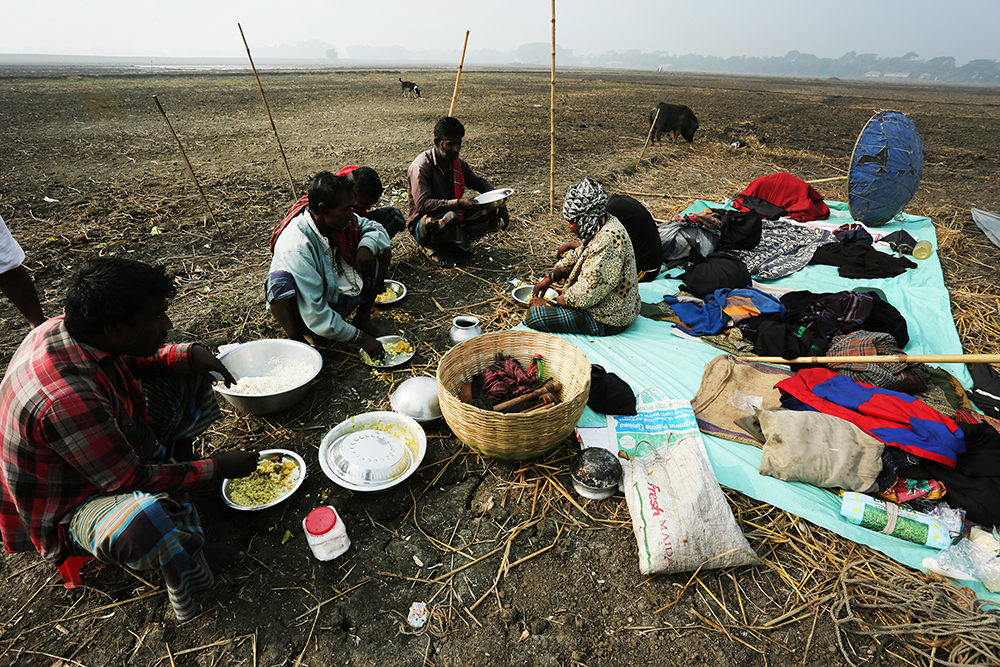 কায়পুত্ররা সকালের খাবার খাচ্ছে, রামদয়িা, গোপালগঞ্জ, ২০১৬। ছবি: ফিলিপ গাইন
কায়পুত্ররা সকালের খাবার খাচ্ছে, রামদয়িা, গোপালগঞ্জ, ২০১৬। ছবি: ফিলিপ গাইন
উল্লেখ্য, গত বছর আগস্টের শেষ দিকে প্রধানমন্ত্রী শেখ হাসিনা সাতক্ষীরা সদর উপজেলাকে ভূমিহীন ও গৃহহীনমুক্ত ঘোষণা করেছিলেন। যদি বাংলাদেশের নাগরিক হিসেবে ধরা হয়, তবে দক্ষিণ আলীপুরের এই ৪৭টি কায়পুত্র পরিবারের অবস্থা তার উল্টোটাই ইঙ্গিত দেয়! এই কায়পুত্র পরিবারগুলো প্রধানমন্ত্রীর কাছে চিরকৃতজ্ঞ থাকবে যদি তিনি তাদের আবাসন সমস্যার সমাধান করে দেন।
দ্রুত বর্ধমান বাংলাদেশে খোলা মাঠে শূকর চরিয়ে জীবনধারণ করা সত্যিকার অর্থে বেশ চ্যালেঞ্জিং। প্রায় ৫০০টি শূকরের একেকটি পালের দেখাশোনার জন্য অনেক অর্থের প্রয়োজন হয়। শূকরপালের মালিকেরা ব্যাংক থেকে ঋণ পান না। মহাজনের কাছ থেকে তারা উচ্চ সুদে টাকা ধার করেন। তারা অনেক সময় এনজিও থেকেও ঋণ নেন, যা তাদের জন্য পর্যাপ্ত নয়। আবার সোয়াইন ফ্লু, কোভিড-১৯ ও নানা অজানা রোগে পালের পর পাল শূকরের মারা যাওয়ার বিরাট ঝুঁকিও রয়েছে।
২০২২ সালের জানুয়ারির শুরুর দিকে শূকরের অনেক পাল অজানা এক রোগে মারা যায়। বিরাট পালের মালিক যশোরের ভায়না গ্রামের দিলীপ মণ্ডল অসহায়ভাবে তার ৭০০ শূকরকে অজানা এক রোগে মারা যেতে দেখেন। তার প্রায় ৫০ লাখ টাকার ক্ষতি হয়। আলাদা আলাদা ব্যক্তির কাছে তার ঋণ ছিল প্রায় ৩০ লাখের মতো। তিনি এখন একদম নিঃস্ব। তিনি আবার ব্যবসায় কবে নাগাদ ফিরতে পারবেন বা আদৌ পারবেন কি না, তা জানেন না। এখানে আরও কায়পুত্র আছেন যারা একইভাবে অজানা রোগে তাদের শুকর মারা যেতে দেখেছেন। স্থানীয়দের রোষানলে পড়ার ভয়ে অনেকেই এসব রোগের ব্যাপারে কোনো রিপোর্ট করেন না।
কায়পুত্ররা পরিবর্তন চায়, সম্মানজনক জীবন চায়। বাংলাদেশ স্বাস্থ্য, শিক্ষা, অর্থনীতি, কর্মসংস্থান সৃষ্টি, মৎস্যসম্পদ ইত্যাদি ক্ষেত্রে উল্লেখযোগ্য অগ্রগতি করেছে। অনেক কায়পুত্র তাদের পেশা পরিবর্তন করেছে। যারা শূকর চরানো ছেড়ে দিয়ে মৎস্য চাষে চলে গেছে, তারা সামাজিক ও অর্থনৈতিকভাবে ভালো করছে বলে মনে করছে। অনেকে তাদের কায়পুত্র উপাধি—মণ্ডল, তরফদার, বিশ্বাস, সরকার—ইত্যাদি পরিবর্তন করে চলেছে। তাদের সন্তানরা অধিক সংখ্যক স্কুলে ভর্তি হচ্ছে। তথাপি, দক্ষিণ আলিপুরের কায়পুত্রদের মতো দক্ষিণ-পশ্চিমের অন্য যেকোনো গোষ্ঠীর তুলনায় অনেক পিছিয়ে আছে। কিন্তু যতদিন তারা তাদের পূর্বপুরুষদের খোলা মাঠে তাদের শূকরের পাল চরানোর পেশায় থাকবে, ততদিন তাদের জন্য রাষ্ট্রীয় এবং অ-রাষ্ট্রীয় পক্ষগুলোর সমর্থন ও সুরক্ষা প্রয়োজন। তাদের জরুরি প্রয়োজনগুলোর মধ্যে অন্যতম নির্ভয়ে শূকর চরানো, লাইসেন্স, বীমা, ব্যাংক ঋণ, সামাজিক সুরক্ষা, মালিকানাসহ খাস জমিতে তাদের ন্যায়সঙ্গত ভাগ, রোগে আক্রান্ত হলে শূকরের চিকিৎসা এবং গৃহপালিত পশু হিসেবে শুকরের স্বীকৃতি।
ফিলিপ গাইন: গবেষক ও সোসাইটি ফর এনভায়রনমেন্ট অ্যান্ড হিউমেন ডেভেলপমেন্টের (সেড) পরিচালক
News Link: bangla.thedailystar.net

by admin | Jun 1, 2024 | Newspaper Report
Rakhals with their herd of pigs, Gopalganj, 2016. Photo. Philip Gain
The Daily Star | June 1, 2024 | Philip Gain
The government term for the community that rears pigs in the open field in Bangladesh is Kawara. The public, in general, also uses the same word but Kawara, in Bangla, is used in a derogatory way implying the community that lives with pigs. Lately, the Kawara people have adopted the term “Kaiputra,” a more respectable term to identify themselves.
If you are travelling through the southwestern districts, especially Satkhira, Jashore, Khulna, Kushtia, Faridpur, Gopalganj, Barishal and Narail, you are likely to see a herd of pigs grazing along the roadside or in a beel. Generally, a flock has 200 to 500 black pigs, almost similar to wild boar in looks. Pigs are considered unholy and therefore unwanted in a Muslim majority country.
However, the pork that comes from the southwestern districts of Bangladesh has high demand among non-Muslims and the big hotels, particularly in Dhaka. The Christians in Dhaka cannot think of celebrating their festivals without pork from the southwestern districts of the country. In fact, black pigs, fed and reared in the open field in these low-lying districts, are routinely slaughtered in Nagori in Kaliganj close to Dhaka and brought to shops in Farmgate. The meat is also supplied to hotels.
We have been following the herds of pigs in a few districts since 2016 for our research interest on the Kaiputra, one of the most miserable and impoverished people of Bangladesh. They leave their families in villages in Satkhira, Jashore and Khulna districts and live with the pigs throughout the year. A herd of 500 pigs require a dozen strong men who are known as rakhals. What I admire most about the rakhals is that they treat the pigs like their siblings. They have particular skills to communicate with the pigs, an intelligent animal.

A herd of pigs in Ramdia, Gopalganj 2017. Photo. Philip Gain
The rakhals indeed feed the pigs, live with them day and night and talk to them. The pigs also listen to them and follow their instructions. The rakhals and pigs in the depth of our beels have an amazing life that we hardly notice. We normally see them when they come on the road to move from one place to another or feed along the roadside.
The rakhals and their origin
The Society for Environment and Human Development (SEHD) has thoroughly mapped the Kaiputra community and published a book, “Kaiputra: Pig Rearing Community” in 2019. SEHD found this community in 46 villages in Jashore, Satkhira and Khulna districts. In 41 of these villages, the Kaiputra community is active in their traditional business of pig rearing in the open. Kaiputras in five of the villages do not send their men as rakhals in the field. In addition to these 46 villages, there are another 29 villages in these three districts, where the Kaiputra communities have taken up fishing. They are no more interested in traditional pig rearing and in identifying themselves as Kaiputra.
The guesstimated Kaiputra population is 12,000. In 2018, the number of herds of pigs reported by the community members was 102 and the number of pigs, 16,296. Some members of the Kaiputra communities also raise pigs in their homes.
Although all Kaiputra people are followers of Hinduism, they are not considered to be within the four Varnas of the caste system and are therefore untouchables. There is no other community in the southwest of Bangladesh so isolated, ostracised, broken, impoverished and socially excluded.
On April 7 and 8, I visited a Kaiputra para in Dakshin Alipur (No. 2 Ward) in Alipur Union of Satkhira Sadar Upazila. The condition of 47 Kaiputra households—39 on the western side and 8 on the eastern side—of the Satkhira-Shyamnagar highway is worse than appalling. Many of the houses are jhupris. The community reported that Around 50 men (rakhals) from this Kaiputra para go out in the field with their herds. Their monthly salary ranges between Tk 3,000 and Tk 9,000 plus a daily allowance for food.
The most appalling thing about the Kaiputra community of Dakshin Alipur is 25 of its female members, all widows and abandoned, beg in neighbouring areas. One of them is Kalyani Mondol (60 and above), who has been begging since her husband, a rakhal, died many years ago. She has a daughter, who has been married off. Kalyani lives in a jhupri, about 6 feet by 6 feet, made of nipa palm leaves, polythene and rusted tins. During rain, she has to sit up and stay awake. She is physically handicapped and walks with the help of a stick. What she gets in widow allowance is hardly enough. She cannot survive without begging.
“Because we beg and our men work with pigs, our neighbours look down on us,” says Shefali Mondol (35), who also begs and sometimes works as a daily labourer. “In tea stalls and hotels in bazar areas, our cups and plates are separate. We are not socially equal to other humans.”
The government reportedly has plans to expand the Satkhira-Shyamnagar Highway into four lanes and has been asking the Kaiputra community to vacate the land they inhabit. The Kaipiutra people are completely landless and have nowhere to go.
They, however, have a suggestion for their relocation. “We are landless and our houses are so flimsy that we consider ourselves homeless,” says China Mondol, a mother of two rakhals. China occasionally begs for a living. “There is plenty of khas land on the western side of our current location. We are repeatedly appealing for pucca houses under Ashrayan scheme to resettle us there.”
It is to be noted that in August the prime minister announced Satkhira Sadar Upazila free of landless and homeless people. The 47 Kaiputra families of Dakshin Alipur in Satkhira Sadar clearly show that the upazila is not free of the landless and homeless, if Kaiputra people are considered citizens of Bangladesh. These families will remain grateful to the prime minister if she resettles each of them on a piece of land.

Kaiputras are having their morning meal, Ramdia, Gopalganj, 2016. Photo. Philip Gain
Living the life of pig graziers in a fast-changing Bangladesh is really challenging. Maintaining a herd of around 500 pigs requires a large sum of money. The owners of the herds do not have access to bank loans. They take loans from moneylenders at a very high interest rate. They also take loans from NGOs, which are inadequate. There are also high risks of swine flu and other unknown diseases that kill pigs in masses.
In January 2022, an unknown disease killed many herds of pigs. Dilip Mondol, owner of a big herd of pigs in Vayana village in Jashore, helplessly watched all of his 700 animals die when an unknown disease struck. His net loss was Tk 50 lakh. His debt to different parties was Tk 30 lakh. He is completely broke now. He is not sure if and when he can come back to business. There are many others who witnessed their pigs’ death after the attack of the unknown disease. Many do not report these diseases in fear of hostility from the locals.
The Kaiputra people want change and a respectful life. Bangladesh has indeed made significant progress in many sectors including health, education, economy, employment generation and fisheries. Many from the Kaiputra community have also changed their occupation. Those who have given up their pig grazer profession and moved to fishing feel they are doing better socially and economically. Many have also been changing their Kaiputra title, Mondol, to Tarafdar, Biswas, Sarkar, etc. Their children are getting admitted to schools in greater numbers. Yet, the Kaiputra like those in Dakshin Alipur are left far behind than any other community in the southwest, where they are concentrated.
As long as they keep taking their pigs for grazing in the open field, a practice they have inherited from their forefathers, they need support and protection from state and non-state parties. Their urgent needs include but are not limited to: the ability to take their pigs for grazing without fear, license, insurance, access to bank loans, social protection, access to khas land with ownership, medical treatment for pigs when they are struck by diseases, and recognition of pigs as domestic animals.
Philip Gain is researcher and director at the Society for Environment and Human Development (SEHD).
News Link: English.thedailystar.net | PDF
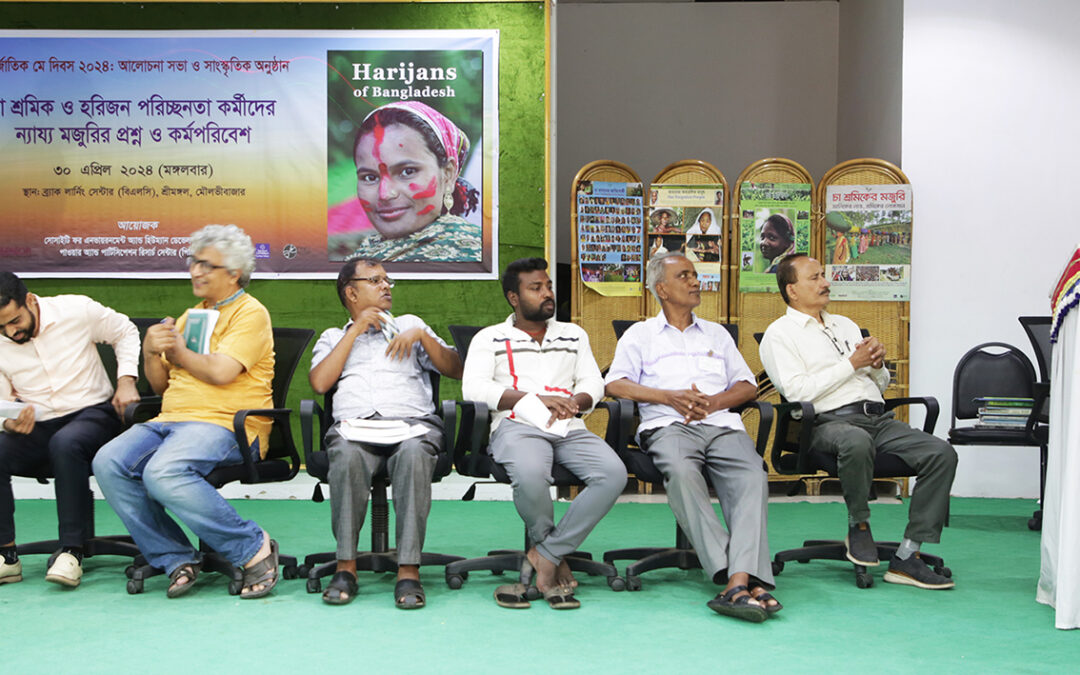
by admin | Apr 30, 2024 | Main Reports, News & Updates
Chief guest Dr. Hossain Zillur speaking at the discussion. Photo. Sanjoy Kairi
What a tragic story of wage deprivation! A Harijan in Sreemangal Municipality, who cleans the streets, gets a remuneration of taka 550 a month! Sukon Bashfor, a Harijan cleaner, employed by the Sreemangal Pourashava, told her appalling story with tear in eyes in a May Day celebration on 30 April 2024. “We work four hours a day and we work every day of the year whatever the weather is,” said Sukon. “There is no holiday for us even on May Day. And our monthly remuneration is only taka 550. To finish the target of cleaning my portion of the streets, my son and my husband join me with broom in hand.”
The Stories of Sukon Bashfor and other Harijan cleaners who live in hovels of Sreemangal Poura Colony were unearthed by two research staff of Society for Environment and Human Development (SEHD)—Rabiullah and Sylester Tudu—and shared at the May Day celebration. The celebration organized by SEHD, Brattyajan Resource Centre (BRC) and Power and Participation Research Centre (PPRC) also highlighted the wage deprivation of the tea workers. While the story of tea workers’ wage deprivation has been widely discussed in recent times, the stunning story of wage deprivation of the Harijan cleaners was as if heard of for the first time.
A hush descended over the audience when Sukon Bashfor and other delegations from the Harijan community from Moulvibazar and Sreemangal spoke.
There are 36 Harijan sweepers in Sreemangal who get this appalling monthly salary for keeping the capital of tea clean and habitable. The jamadar (supervisor) gets taka 580 a month. The Bangalee cleaners who reportedly work eight hours get a daily wage of taka 400.
Kanti Lal Bashfor, the president of Bangladesh Horijan Yokkha Parishad (BHYP) reported that in Habiganj Municipality, a Harijan cleaner gets a monthly salary of taka 900 for the same work, which is taka 3,500 for those of the Harijan community employed by the Moulvibazar Municipality. He also shared information on monthly salaries of Harijans in eight municipalities and one city corporation in Sylhet division.
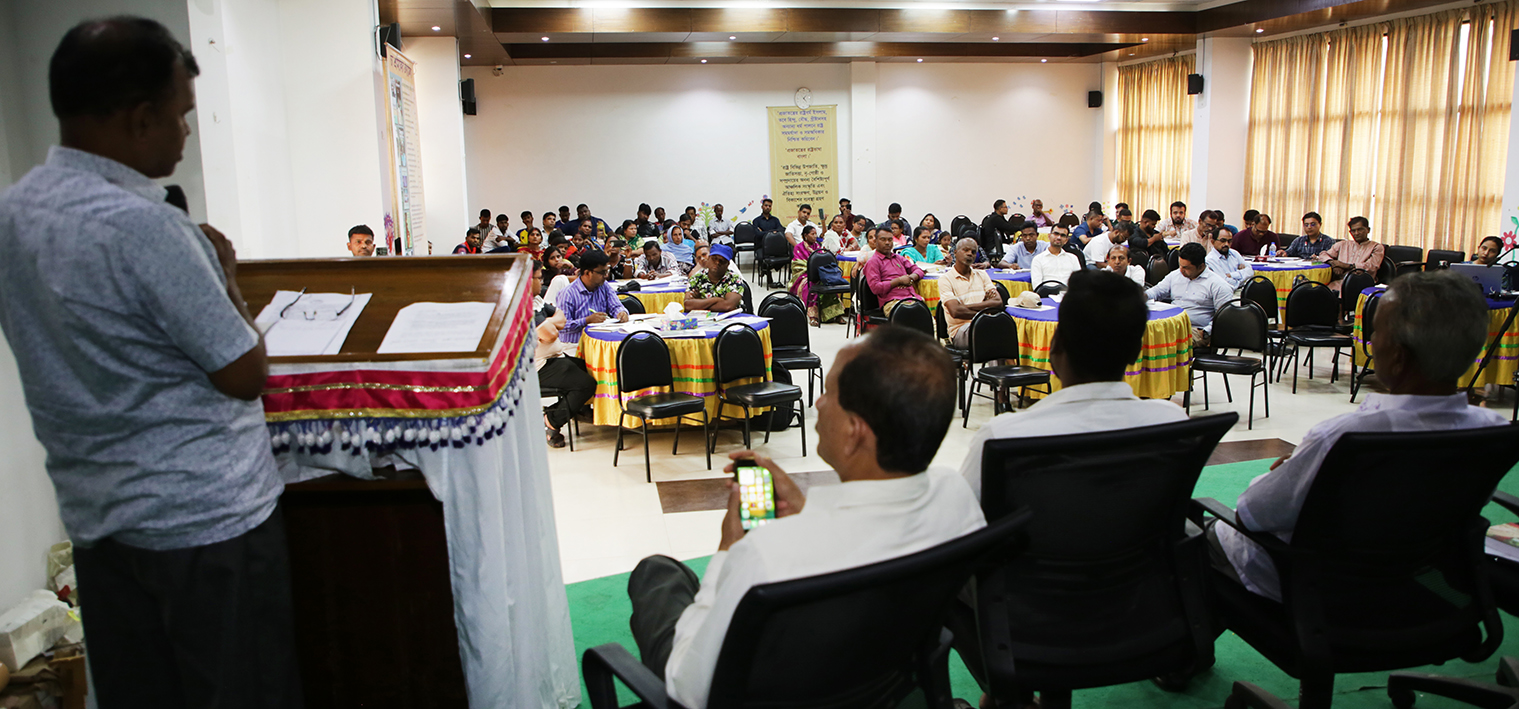
Audience at the discussion. Photo. Sanjoy Kairi
Frustrated Kanti Lal Bashfor shared in angry tone: “The occupational skills of cleaners does not improve when the income is so meagre. When we go hungry, many of us lose their sense and engage in selling alcohol and marijuana.”
Sagar Harijan, the jamadar in Sreemangal added, “We Harijans do not get any health protection, pension and even any compensation or leave in emergencies such as accidents.”
The salaries of Harijan cleaners sweeping the streets in municipalities range from taka 550 to 4,000 and taka 3,000 to 17,000 in city corporations around the country. Among the cleaners who clean drains and transport waste in trucks are little better paid. Those who work in government offices, universities, colleges, hospitals, railway, etc. are on get government scales and get salaries between taka 12,000 and 25,000.
The key demand of the Harijan cleaners is that they get unified respectable salary scales. They also demand that the prime minister’s directive to provide 80% of cleaning jobs in municipalities and city corporations to the Harijans who allege that currently others are taking their jobs.
In his keynote presentation on the question of tea workers’ just wages, Philip Gain, researcher and director of SEHD, focused on the wage deprivation of tea workers. The current daily wage of a tea worker (Taka 170) which was fixed by the prime minister in the backdrop of an unprecedented strike in the tea garden in August 2022 is still inadequate. The tea workers’ wage has never been just. During the 1880s and 1890s the average monthly wage of a tea worker in Assam (Sylhet division was part of Assam back then), was six rupees. With this little income, they were not able to buy enough rice for the month. Back then a maund (40 kg) of rice would cost two rupees. The tea workers could spend one rupee. The owners then would add one rupee. Thus, the owners introduced subsidy for staple. Some other fringe benefits including medical care was also introduced. Thus, the owners invented techniques to keep the tea workers tied to the tea gardens in the post-slavery era. However, many see the tea workers and Harijans as modern slaves.
In Bangladesh the owners have followed the same techniques to not give the just cash wages to the tea workers and to keep the tea workers, most of them low caste Hindu and non-Bangalee, tied to the tea gardens.
What is most painful for the tea workers of Bangladesh is the owners have never paid them gratuity, shared company profit and have routinely violated several important sections of the labour legislations that are supposed to ensure decent work conditions, standard education and medical care among others. Violation of labour legislations indeed is the single most important factor for unjust wages and indecent work conditions.
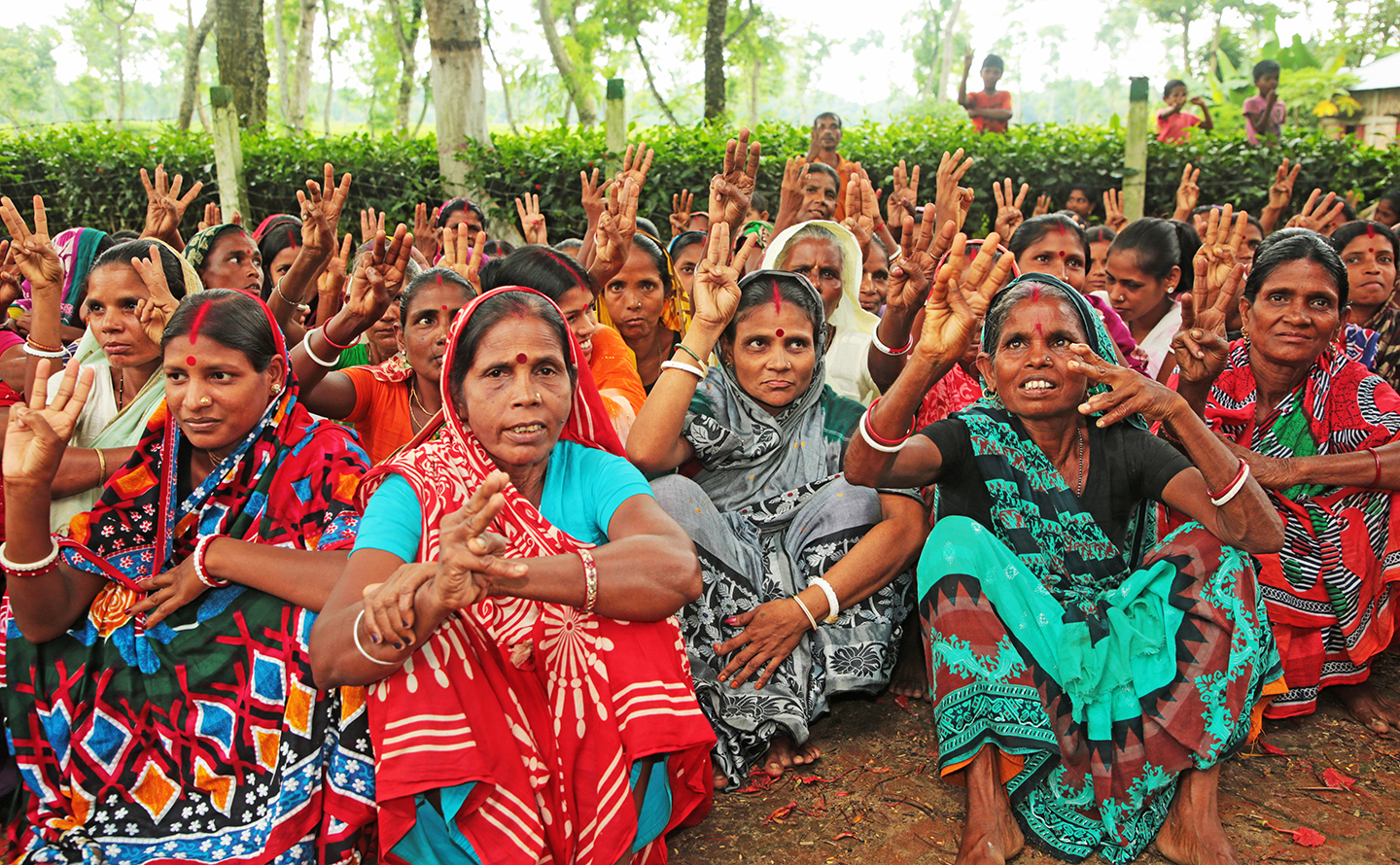
Women tea workers in a rally during the August strike in 2022.Photo.Philip Gain
The speakers from the tea community and their lone union, Bangladesh Cha Sramik Union (BCSU) spoke on different aspects of wage deprivation and indecent work conditions, their causes and consequences.
Mr. Rambhajan Kairi, vice chairman of Kamalganj Upazila and trade union leader talked about how employers in tea gardens abuse labour legislations in their best interest and are not held accountable even though there are flagrant violations at their end. “In Bangladesh, legislation is used to deprive our tea workers,” Mr. Kairi remarked. “Whenever the price of tea falls, every tea worker has to bear the consequences. But when profits are made, that never reach the workers.”
Ms. Jasmine Akhter, vice president of BCSU commented on the status of women tea workers. “Despite the fact that majority of the tea leaf pluckers are women, they are not valued and respected either in the gardens or in their families,” said Ms. Akhter. “If they demand a just wage, they hear all about owners’ loss. And if they protest against injustice, they face trouble in every possible way.”
Mr. Paresh Kalindi, the treasurer of BCSU and Mr. Nripen Pal, acting general secretary of BCSU also spoke to raise community voice.
After the community voices heard, a panel of researchers, academic, lawyer, government official led the discussion into a root cause analysis and shared their thoughts on what needs to be done to pull the Harijans and tea workers out of their current appalling condition.
Mohammad Mahbubul Hasan, Deputy Inspector General of Department of Inspection for Factories and Establishments (DIFE) in Sreemangal reflected on what his agency does for the workers. DIFE indeed is an important government agency to ensure implementation of labour legislations and well-being of the tea workers in particular. In his discussion he highlighted particularly how DIFE helps in getting financial aid to university students from tea gardens.
Katyayani Chandola, a lawyer from India represented NAZDEEK, a US-based advocacy group supporting work with tea workers in India and Bangladesh talked about the wages of tea workers in India and the plight of those in Assam. “Currently in Assam, the daily wage of a tea worker is Rs. 250, which however, is more than Rs. 400 in several other regions such as Tamil Nadu and Kerala. Now the tea workers of all the states of India are demanding that the minimum wages be fixed for all the states using the Supreme Court’s formula,” reported Chandola. “If wages were determined using the formula, the minimum wage would now be more than Rs. 500.”
Prof. Tanzimuddin Khan of University of Dhaka spoke on how to minimise the anomalies with wages. A country should put a standard in place to ensure just wages. “What we see in tea gardens and with Harijans is severe disrespect to social justice and dishonour to the spirit of the May Day,” said Prof. Khan. “Instead of different wage structures for different sectors, all unions should come together and demand a universal minimum wage for all sectors.”
Dr. Hossain Zillur Rahman, the chief guest at the celebration, reflected on wage deprivation of the Harijans and tea workers and how different actors can play a right role in giving them honour. “It is very important to specify the problems of our marginalized groups and work on solutions through strategic thinking,” said Dr. Rahman.
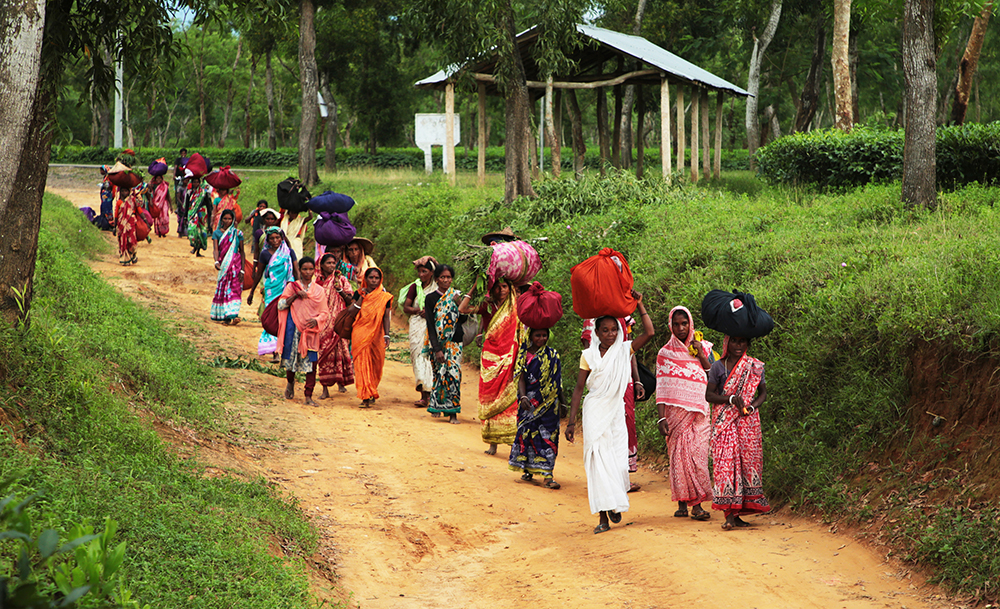
Women tea worker return home after day’s hard work.Photo.Philip Gain
“The most harmful aspect of marginalization is when people feel marginalized and powerless,” remarked Dr. Rahman. “It is very important for them to have the ability to show their potentials. Brattyajan Resource Centre (BRC) is helping the marginalized and excluded communities and giving them a platform through its continuous research. Journalists also have a responsibility in strengthening research and investigation.”
The Harijans and the tea workers have a similar history of migration to their current locations from different parts of India. The Harijans are traditionally known as sweepers and many of them consider themselves social outcasts or ‘Dalit’. The term, ‘Dalit’ is used to define the status of those who are outside the four Varnas in the Hindu Casteism, which means they belong to the so-called fifth category. The members of the Harijan community work as cleaners in the cities and municipalities all over the country except for three districts of Chittagong Hill Tracts (CHT). They are among the most neglected in society and most deprived of all social privileges. Cleaning has been their main occupation for more than 200 years now. The Harijans with a population of around 100,000 are among the most marginalised communities who are afflicted with a variety of social and economic problems.
The 138,000 tea workers and their communities of half million people, most of them Hindus and considered the fifth category in the Hindu casteism, also migrated to their current locations to work in the tea gardens. Tied to the tea gardens for five generations they now work in 160 tea gardens in Sylhet and Chattogram divisions. The British companies had started bringing them from Bihar, Madras, Odisha, Andhra Pradesh, Madhya Pradesh, West Bengal, Uttar Pradesh and other places in India to work in the tea gardens in Sylhet region from the 1850s. Engagement of these non-local communities was a post-slavery innovation to address the labour needs of colonial capitalist enterprises. The misfortune of these indentured labourers started with their journey to the tea gardens. The tea workers, belonging to as many as 80 ethnic identities, are also among the most deprived, exploited, alienated, excluded, poorest and marginalized peoples of Bangladesh.
The tea workers have many sad stories to tell. But their cultural riches demonstrate their inner strength. The songs, dances and a drama that the artists of ‘Pratik Theatre’ displayed to kick off the celebration on 30 April amazed everyone in the audience. Pratik Theatre, a premier cultural group among more than a dozen of them in the tea gardens, is based in Deundi Tea Estate. Established in 1986, the group now has more than 60 artists. Pratik Theatre is famed for nurturing cultural riches and making people aware of social, economic and political injustices that the tea workers face. It routinely organizes cultural events inside and outside the tea gardens to promote rights of the tea workers.
Philip Gain, research and director and Fahmida Afroze Nadia, researcher at Society for Environment and Human Development (SEHD).
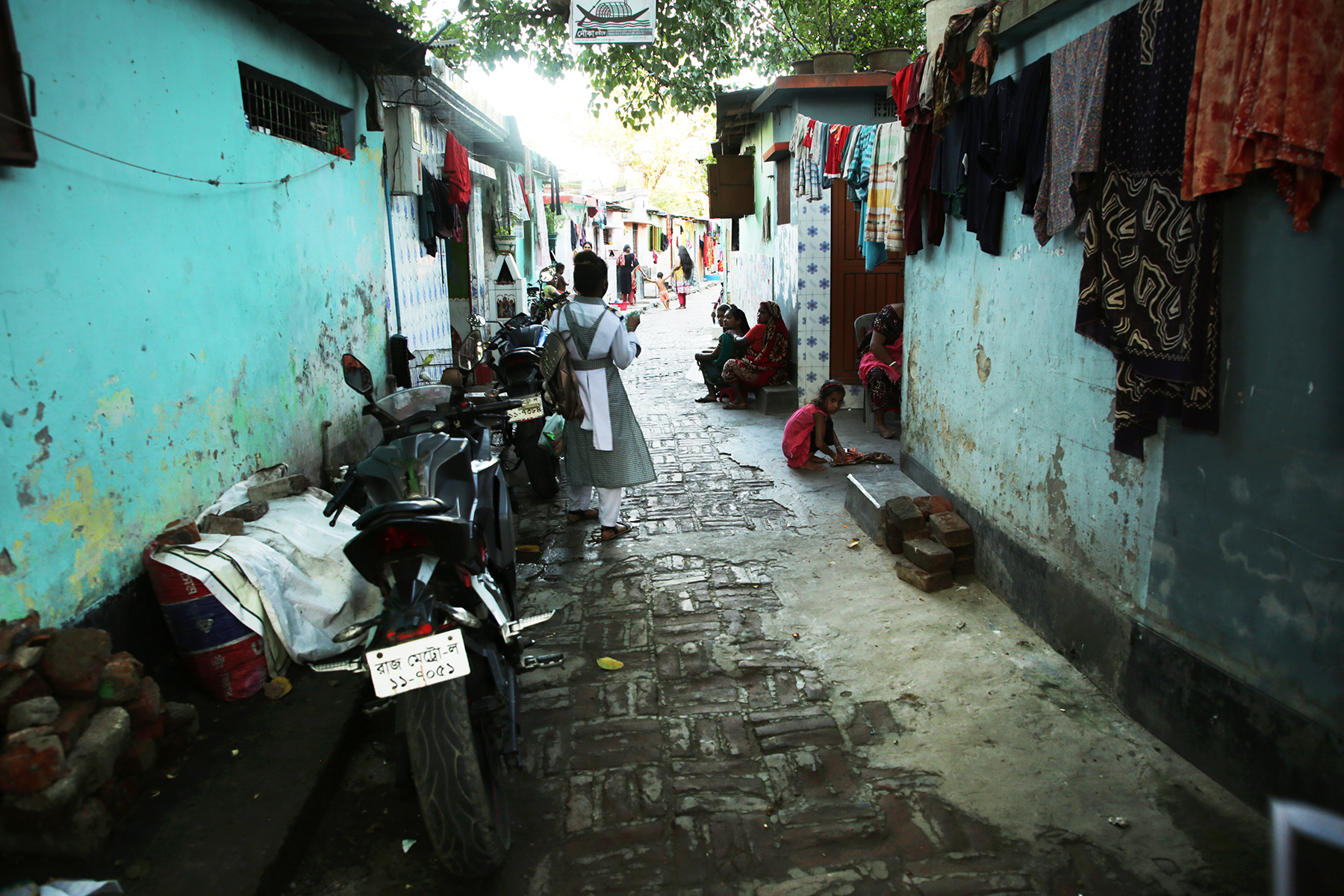
A Harijan colony in Mymensingh, flooded with rainwater. Photo. Philip Gain
News Link: Dhaka Courier || Bangla PDF

 চা-শ্রমিকের প্রতি সুবিচার নিশ্চিত করতে আরেকটি উদ্বেগের বিষয় শ্রম আইন ও শ্রম বিধিমালায় তাদের প্রতি বৈষম্য।
চা-শ্রমিকের প্রতি সুবিচার নিশ্চিত করতে আরেকটি উদ্বেগের বিষয় শ্রম আইন ও শ্রম বিধিমালায় তাদের প্রতি বৈষম্য।


 শূকরের পাল নিয়ে রাখাল, গোপালগঞ্জ, ২০১৬। ছবি: ফিলিপ গাইন
শূকরের পাল নিয়ে রাখাল, গোপালগঞ্জ, ২০১৬। ছবি: ফিলিপ গাইন কায়পুত্ররা সকালের খাবার খাচ্ছে, রামদয়িা, গোপালগঞ্জ, ২০১৬। ছবি: ফিলিপ গাইন
কায়পুত্ররা সকালের খাবার খাচ্ছে, রামদয়িা, গোপালগঞ্জ, ২০১৬। ছবি: ফিলিপ গাইন



